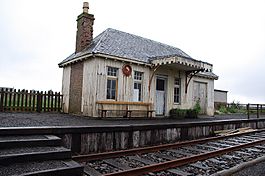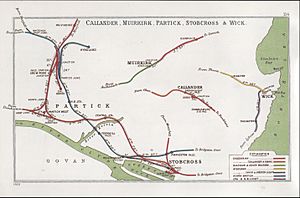Wick and Lybster Light Railway facts for kids
Quick facts for kids Wick and Lybster Light Railway |
|
|---|---|

Remains of Thrumster railway station
|
|
| Overview | |
| Locale | Scotland |
| Stations | 8 |
| History | |
| Opened | 1 July 1903 |
| Closed | 3 April 1944 |
| Technical | |
| Line length | 13 miles 39 chains (21.7 km) |
| Track gauge | 4 ft 8 1⁄2 in (1,435 mm) |
The Wick and Lybster Light Railway (W&LLR) was a special kind of railway that opened in 1903. It was built to connect the small fishing port of Lybster in Scotland to the main railway network at Wick. This helped people and goods travel more easily.
Building the railway cost a lot of money. Local councils and the government's Treasury helped pay for it. The Highland Railway company operated the trains on the line.
However, the railway was never used as much as people hoped. The fishing business in Lybster didn't grow as expected. In the 1930s, a new, modern road was built. This road made it much faster to travel from Lybster. Because of this, the railway closed completely in 1944.
Contents
A Railway's Story
Lybster was a fishing village about 21 kilometers (13 miles) south of Wick. Before the 1900s, it was hard to reach by land. People had thought about building a railway there as early as 1864, but it didn't happen then.
In 1896, the government passed a law called the Light Railways Act. This law was made to help build cheaper railways in places like Lybster. These "light railways" were simpler and less expensive to build than regular ones.
When a new light railway was suggested for Lybster, many local people supported the idea. Wick was already a major railway stop on the Far North Line from Inverness. This line was run by the Highland Railway company.
Local leaders, especially the Caithness County Council, applied for permission to build the railway. They got the official approval, called the Wick and Lybster Light Railway Order 1899, on November 27, 1899.
Funding the Project
The railway company needed a lot of money to build the line. The Duke of Portland, a rich landowner, gave £15,000. The Highland Railway company also gave £1,000. Local councils like Caithness County Council and the Corporation of Wick also contributed. The government's Treasury gave a large grant of £25,000.
The Highland Railway company agreed to manage the building work. However, they wanted local leaders to promise that any extra costs would be covered. This caused some delays, but eventually, the Treasury agreed to give an extra £5,000 in 1900. A final agreement with the Highland Railway was made in February 1901.
Building and Opening the Line
Construction of the railway began on April 1, 1901. The plans were drawn by William Roberts, the chief engineer for the Highland Railway. Inspectors from the Board of Trade checked the line as it was being built.
After a final inspection, the railway officially opened on July 1, 1903. The first train left Wick at 11:00 AM. The engine was named Lybster and was decorated with flags. Mrs. Miller, the chairman's wife, blew a whistle to signal the train's departure. She received a gold whistle as a souvenir. The first train traveled straight to Lybster in about 30 minutes.
Every weekday, three trains ran in each direction. The journey took about 40 minutes. Trains were allowed to travel up to 40 kilometers per hour (25 miles per hour).
The railway never made much money. When the town of Wick voted to stop alcohol sales, some people traveled to Lybster by train to buy drinks.
In 1921, a big change happened for railways in Great Britain. Many smaller railway companies joined together to form larger ones. The Highland Railway became part of the new London, Midland and Scottish Railway (LMS). The Wick and Lybster Light Railway was also taken over by the LMS.
An 0-4-4 tank locomotive was used on the Wick and Lybster Light Railway starting in 1903. It was a special type of steam engine.
The Railway's Path
The railway line was about 22 kilometers (13 miles) long. It had only one track, so trains could not pass each other along the way. There were also many places where the railway crossed roads.
At Wick station, a new platform was built just for the Lybster trains. The line started near Wick station and curved south. It then ran inland for about 1.6 kilometers (1 mile) before turning west. It followed the coast and ended at Lybster.
There were also stations in between Wick and Lybster. These included Thrumster, Ulbster, Mid Clyth, and Occumster.
The area around the railway was rocky and hilly. This meant the trains had to climb steep slopes. From Wick, the line went uphill almost all the way. It reached its highest point, about 100 meters (328 feet) above sea level, before the 11-kilometer (7-mile) mark. The last kilometer into Lybster station was downhill. Lybster station was higher than Wick station. The station in Lybster was at the north end of the main street, a little distance from the harbor.
Why the Railway Closed
In the 1930s, a new, modern road was built over the Ord of Caithness. This road was great for the area, but it meant the end for the railway. Traveling from Lybster to Helmsdale by train, going through Wick, was about 119 kilometers (74 miles). But by the new road, it was just over 32 kilometers (20 miles).
The railway closed completely after the last train ran on April 1, 1944. John Skene, who had driven the very first train in 1903, was also the driver for the last trip. Many people gathered at Lybster station for the final train, which was decorated with flags. By September of that year, the railway tracks were being taken apart.
See also


